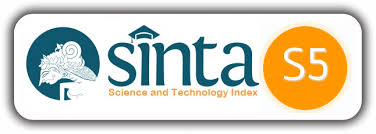Hubungan Dukungan Keluarga Terhadap Self-management Lansia Dengan Penyakit Tidak Menular di Posyandu Lansia/ Family Support Relation to Self-management of Elderly with Non-communicable Diseases
DOI:
https://doi.org/10.55642/phasij.v4i01.716Kata Kunci:
family, elderly, non-communicable diseases, self-managementAbstrak
Non-communicable diseases are diseases whose incidence continues to increase with age. The aim of this research is to find out whether there is a relationship between family support for elderly self-management and non-communicable diseases (NCDs) at the PKM Rangkasbitung Banten Elderly Posyandu. This research used a cross sectional design with a sampling number of 71 respondents, sampling using a total sampling technique. The results obtained were that the majority of respondents were women 41 (57.7%) and the ages of the respondents were mostly young elderly (60-69 years), namely 40 (56.3%) and the majority of respondents suffered from hypertension 51 (71.8%). Of the 42 (59.2%) respondents who received high support, 39 (92.9%) had high self-management and 3 (7.1%%) respondents who received low family support. The results of the chi square analysis obtained a p value of 0.000 (p<0.05) with an odds ratio value of 18.42, this shows that there is a significant relationship between family support and self-management of the elderly and PTM at PKM Rangkasbitung Banten. It is expected that health workers and their families can provide support and motivation to the elderly to improve their health status, especially in improving self-management of the PTD disease they suffer from.
Referensi
Adhania, C. C., Wiwaha, G., & Fianza, P. I. (2018). Prevalensi Penyakit Tidak Menular pada Fasilitas Kesehatan Tingkat Pertama di Kota Bandung Tahun 2013-2015. Jurnal Sistem Kesehatan, 3(4), 204–211. https://doi.org/10.24198/jsk.v3i4.18499
Agung Premananda, I. G., Tjahyanto, A., & Mukhlason, A. (2022). Design Science Research Methodology and Its Application to Developing a New Timetabling Algorithm. 433–438. https://doi.org/10.1109/CyberneticsCom55287.2022.9865661
Al-Dahshan, A., Al-Kubiasi, N., Al-Zaidan, M., Saeed, W., Kehyayan, V., & Bougmiza, I. (2020). Prevalence of polypharmacy and the association with non-communicable diseases in Qatari elderly patients attending primary healthcare centers: A cross-sectional study. PLoS ONE, 15(6 June). Scopus. https://doi.org/10.1371/journal.pone.0234386
Aparicio-Rodríguez, Y. D., Alonso-Morillejo, E., & García-Torrecillas, J. M. (2023). Epidemiological Situation of High-Prevalence Non-Communicable Diseases in Spain: A Systematic Review. Journal of Clinical Medicine, 12(22). Scopus. https://doi.org/10.3390/jcm12227109
Feng, Z., Liu, X., Yang, W., & Phillips, D. R. (2024). Public expenditure on health care and the incidence of non-communicable diseases (NCDs) in China from 2008 to 2018. Maturitas, 183. Scopus. https://doi.org/10.1016/j.maturitas.2024.107963
Han, H., Youm, J., Tucker, C., Teal, C. R., Rougas, S., Park, Y. S., Mooney, C. J., Hanson, J. L., & Berry, A. (2022). Research Methodologies in Health Professions Education Publications: Breadth and Rigor. Academic Medicine, 97(11), S54–S62. Scopus. https://doi.org/10.1097/ACM.0000000000004911
Harisa, A., Arfan, A. F., Ramadhani, W. A., & Pahruddin, M. N. S. (2022). Journal of Holistic Nursing Science Determinant of self-management in chronic non-communicable. 9(2), 51–57
Heryana, A. (2020). Penanggulangan Penyakit Tidak Menular. Prodi Kesmas Universitas Esa Unggul, 1–15.
Jengan, N., Pradidthaprech, A., Choomsri, P., Sae-Ung, K., Sitakalin, P., & Laoraksawong, P. (2022). Factors Associated with the Quality of Life in the Elderly with Non-Communicable Diseases in Nakhon Si Thammarat, Thailand. Trends in Sciences, 19(4). Scopus. https://doi.org/10.48048/tis.2022.2688
Kalsum, U., Lesmana, O., & Pertiwi, D. R. (2019). Patterns of non-communicable disease and risk factors of anak dalam ethnic group in nyogan village jambi province. Media Kesehatan Masyarakat Indonesia, 15(4), 338–348. https://doi.org/10.30597/mkmi.v15i4.7062
Kemenkes. (2019). Buku pedoman manajemen penyakit tidak menular. Kementerian Kesehatan Indonesia, 2.
Kusumawaty, J., Hidayat, N., & Ginanjar, E. (2018). Hubungan Jenis Kelamin Dengan Intensitas Hipertensi pada Lansia di Wilayah Kerja Puskesmas Lakbok Kabupaten Ciamis. Jurnal Mutiara Medika, 16(2), 46–51.
Marmamula, S., Modepalli, S. B., Kumbham, T. R., Challa, R., & Keeffe, J. E. (2021). Prevalence of disabilities and non-communicable diseases in an elderly population in the Telangana state, India: A population-based cross-sectional study. BMJ Open, 11(2). Scopus. https://doi.org/10.1136/bmjopen-2020-041755
Mujiadi, & Rachmah, S. (2022). Buku Ajar Keperawatan Gerontik. In STIKes Majapahit Mojokerto.
Nuraeni, E. (2019). Hubungan Usia Dan Jenis Kelamin Beresiko Dengan Kejadian Hipertensi Di Klinik X Kota Tangerang. Jurnal JKFT, 4(1), 1. https://doi.org/10.31000/jkft.v4i1.1996
Putri, Elki, S. (2020). Strategis Untuk Mengoptimalkan Manajemen Diri Lansia Dengan Hipertensi. Jurnal Penelitian Kesehatan Suara Forikes, 11, 22–29.
Rahmawati, Werdati, S., & Inayati, A. (2019). Hubungan Dukungan Keluarga Dengan Self Care Pada Lansia dengan Diabetes Melitus Tipe 2 di Puskesmas Kasihan II Bantul Yogyakarta (Issue 1). http://elibrary.almaata.ac.id/1188/1/B. ABSTRACT.pdf
Ramírez, J. P., Marchena, M. B., Rebatta, F. B., Valladares, E. R., & Zamora, R. A. (2022). Frequency and factors associated with chronic non-communicable diseases in older adults in Peru, 2005. Anales de La Facultad de Medicina, 83(4), 299–306. Scopus. https://doi.org/10.15381/anales.v83i4.24333
Rusmini, Kurniasih, H., & Widiastuti 3, A. (2023). PREVALENSI KEJADIAN PENYAKIT TIDAK MENULAR (PTM). Politeknik Kesehatan Kementerian Kesehatan Semarang, 4(1), 88–100.
Sartika, I., Mustikasari, & Azzam, R. (2022). Hubungan Self Efficacy dan Dukungan Keluarga dengan Self Management Pada Lanjut Usia Diabetes. Dunia Keperawatan : Jurnal Keperawatan Dan Kesehatan, 10(3), 331–340. https://doi.org/10.20527/dk.v10i3.153
Siregar, P. A., & Susilawati. (2023). Hubungan faktor usia dengan kejadian PTM di wilayah Puskesmas Desa Aek Goti. Jurnal Ilmiah Kesehatan, 2(1), 11–14.
Taswin, T., Nuhu, R. M. A., Amirudin, E. E., & Subhan, M. (2022). Hubungan Self Care dengan Kualitas Hidup Pasien Diabetes Melitus di Wilayah Kerja Puskesmas Bungi di Kota Baubau. Jurnal Kesehatan Indonesia, 12(2), 109–115. http://journal.stikeshb.ac.id/index.php/jurkessia/article/view/399
Utami, A. P., & Hudiyawati, D. (2023). Gambaran dukungan keluarga terhadap Self Management penderita Hipertensi. Jurnal Keperawatan Silampari, Volume 6, 9–15. http://repository.urecol.org/index.php/proceeding/article/view/1117%0Ahttp://repository.urecol.org/index.php/proceeding/article/download/1117/1088
Wahyuni, T., & Parliani. (2021). Buku Ajar Keperawatan Keluarga (R. Awahita (Ed.)). CV Jejal. https://repo.stikmuhptk.ac.id/jspui/bitstream/123456789/311/1/Buku Ajar Keperawatan Keluarga.pdf
WHO. (2023). Noncommunicable Diseases (NCDs)WHO. (2023). Noncommunicable Diseases (NCDs). World Health Organization. www.who.com. World Health Organization. www.who.com















